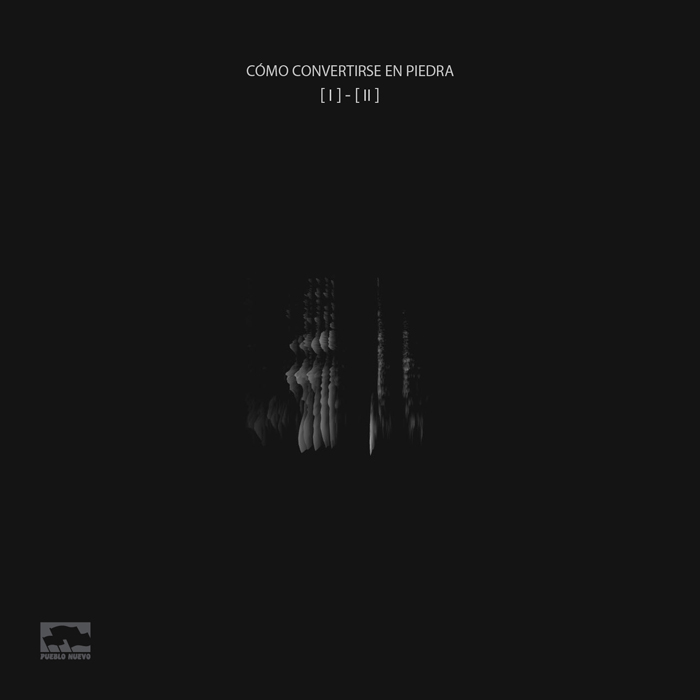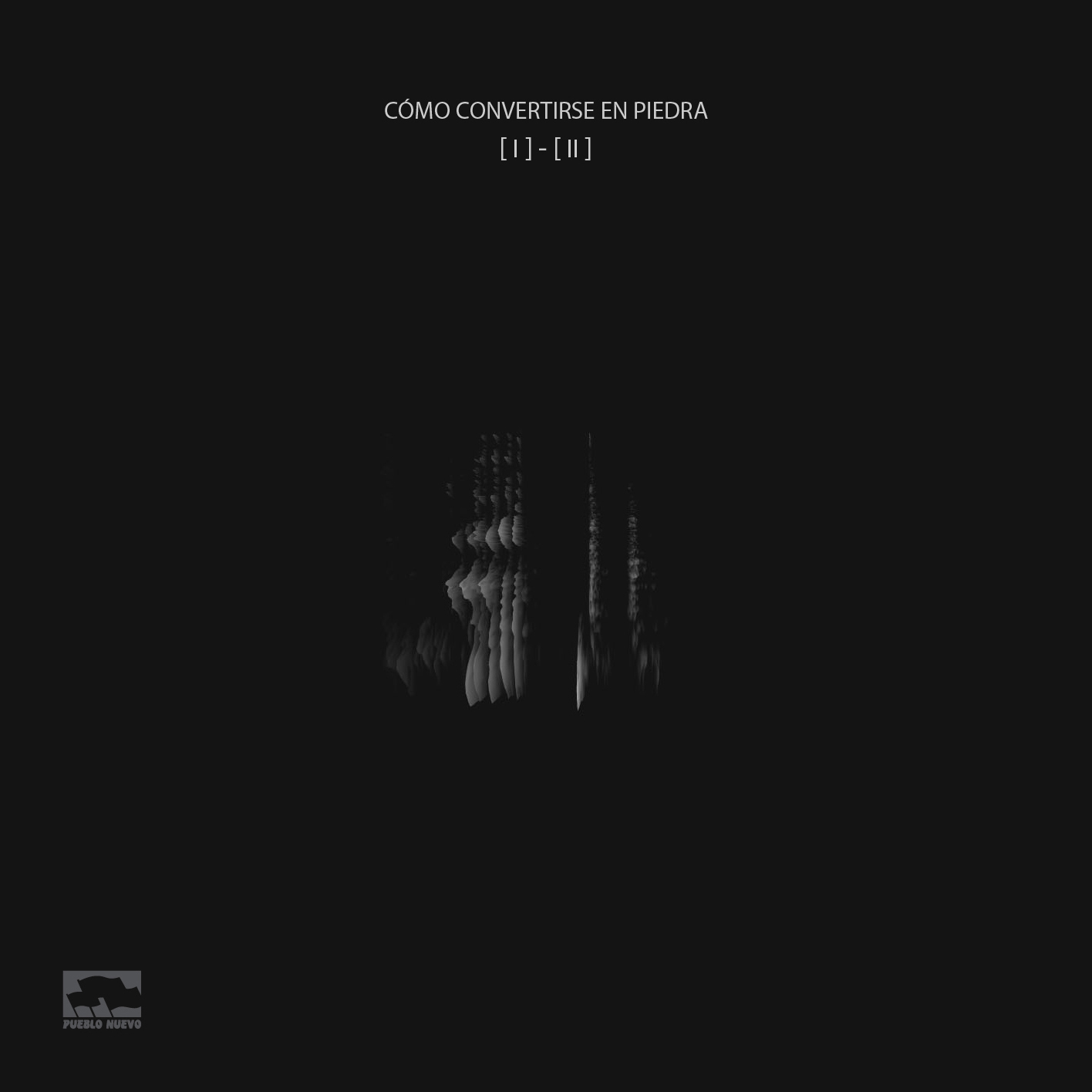[pn198] Cómo Convertirse en Piedra [I] – [II] 2021
by Valentina Villarroel [Chile]

Track list
Pueblo Nuevo Netlabel se complace en presentar el disco doble “Cómo Convertirse en Piedra – Parte I & Parte II”, de la artista sonora y experimental chilena Valentina Villarroel.
Pueblo Nuevo Netlabel is pleased to present “Cómo Convertirse en Piedra – Parte I & Parte II”, double album by Chilean experimental and sound artist Valentina Villarroel.
PRESENTACIÓN / OVERVIEW:
Composición de piezas sonoras realizadas para la obra teatral “Cómo Convertirse en Piedra” de la dramaturga Manuela Infante, estrenada el 2021. El álbum se compone de dos partes. “Cómo Convertirse en Piedra – Parte I”, es el resultado del trabajo a partir de registros de paisajes sonoros y ruidos concretos y “Cómo Convertirse en Piedra – Parte II”, es el resultado del trabajo con fragmentos de voces erosionadas.
Composition of sound pieces for the theatre play “Cómo Convertirse en Piedra” (How to become a stone) by the playwright Manuela Infante, premiered in 2021. The album consists of two parts. “Cómo Convertirse en Piedra – Part I”, is the result of working from records of soundscapes and concrete noises, and “Cómo Convertirse en Piedra – Part II”, is the result of working with fragments of eroded voices.
Reseña / Review:
Este disco de la artista sonora chilena Valentina Villarroel es parte de la banda sonora de una obra de teatro y está dividido en dos secciones, cada una de las cuales contiene trece y catorce temas respectivamente. Según la artista, estas partes se distinguen entre sí a partir de las fuentes sonoras de las que nacieron, las grabaciones de paisajes sonoros en el primer caso y los fragmentos de voz en el segundo.
El mundo sonoro que presenta Villarroel en la primera parte está compuesto principalmente por sólidos y enormes bloques de sonido, como una densa niebla cuyo espesor parece contener fuertes fuerzas que impulsan su propio flujo interno. De hecho, hablado desde una perspectiva espectral, a pesar de la presencia o ausencia de continuidad en los sonidos, es decir, atmósferas prolongadas o texturas iterativas, a menudo hay una amplia cobertura del dominio de la frecuencia. De esta forma, la sensación general es estar expuesto auditivamente a entidades fuertes, algunas de ellas con variaciones en su frecuencia, como glissandi o una especie de melisma (aplicando libremente esta noción a estos sonidos no acústicos y no instrumentales). Dentro de estas enormes masas espectrales, hay espacio para los detalles que emergen de la niebla, debido a la disipación ocasional de la densidad. Toda vez que una pieza no tiene tal densidad, se le da forma a través de un alto contraste de materiales espectrales o, por ejemplo, mediante un bloque específico en el rango bajo. Este es el aspecto más característico del conjunto, desde el cual las piezas muestran sus diferencias, por ejemplo, siendo a veces toscas, a veces más suaves, pero siempre manteniendo un carácter atmosférico, incluso cuando una pieza está conformada por repeticiones de un sonido de tipo ataque-impulso como en el sexto trabajo de la primera parte. Consecuentemente, el discurso sónico no está impulsado de manera importante por otros aspectos como la intensidad o notables fluctuaciones diacrónicas de los sonidos. Evidentemente, hay algunas excepciones como la octava obra de esta primera parte, una construcción basada en el sonido de agua que fluye, o la duodécima pieza, basada en una granulación de textura irregular.
La segunda parte se destaca de la primera, principalmente por los materiales de voz que ahora se presentan mayoritariamente de tal manera que los podemos reconocer. Puedo reconocer lo que me atrevo a llamar una ”estética distintiva”: el tratamiento fuerte y rudo del material sonoro, con ataques bruscos y nuevamente espesores espectrales y ligeras variaciones de sonoridad. Por ejemplo, los impulsos e iteraciones de masa compleja (en la terminología de Schaeffer) dialogan con muestras vocales con algunas repeticiones producidas con un efecto de retardo clásico (delay) en la segunda obra de la segunda parte. No hay espacio para la delicadeza. La palabra hablada es presentada por lo que parece ser una voz masculina o una voz femenina en diferentes pistas (con tantas transformaciones electroacústicas posibles hoy en día, ¡nunca se sabe!). Las frases se repiten, el delay juega un papel rítmico simple (quizás ingenuo). Hay algo que encontré interesante: los cambios de atención producidos a través de movimientos entre el contenido semántico claro y la disolución de este. A veces el material vocal, dentro de una pieza concreta, presenta una disolución semántica total (Albornoz 2018, pp. 39-40). Tratamientos clásicos de las grabaciones de voz también están presentes, como el estiramiento probablemente mediante una forma de síntesis granular y el cambio de tono, quizás las acciones más predecibles del álbum, al menos desde mi punto de vista.El espacio, en términos generales, tanto en la primera parte como en la segunda parte del álbum, no está muy desarrollado y parece ser abordado esencialmente mediante un posicionamiento recatado en el panorama estéreo y la inclusión de reverberaciones.Otro tipo de material interesante lo constituye el aislamiento y estiramiento de partículas fonéticas, como en el caso de una unidad fricativa en la vigesimoquinta pieza de la segunda parte.
Claramente funcional para una obra de teatro, el álbum presenta piezas cortas con esta particular estética de enormes densidades espectrales, aproximaciones minimalistas a los materiales sonoros y un delicado sentido de variaciones: sólidos bloques de sonidos que dan forma a piezas sólidas que a su vez conforman un sólido álbum, todo sólido y poético como pudiera ser la transformación de un ser en una piedra.
This album by the Chilean sound artist Valentina Villarroel is part of the soundtrack for a theatre play and its divided in two sections, each of which contents thirteen and fourteen tracks respectively. According to the artist, these parts are distinguishable from each other based on the sound sources from which they were born, soundscape recordings in the first case and voice fragments in the second.
The sound world that Villarroel presents in the first part is mainly compound by solid and huge blocks of sound, as a dense mist which thickness seems to contain strong forces driving its own inner flux. In fact, spoken from a spectral perspective, in spite of the presence or absence of continuity in the sounds, namely prolonged atmospheres or iterative textures, there is often a wide coverture of the frequency domain. In this way, the general sensation is to be aurally exposed to burly entities, some of them with variations on their frequency, like glissandi or a sort of melisma (applying freely this notion to these non-acoustic and non-instrumental sounds). Within these huge spectral masses, there is space for details emerging from the mist, due to the occasional density dissipation. Whenever a piece has not such a density, it is shaped by a high contrast of spectral materials or, for instance, a specific block in the low range. This is the most characteristic aspect of the set, from which the pieces show their differences, for example being sometimes rough, sometimes smoother, but always maintaining an atmospheric nature, even when a piece is shaped by repetitions of an attack-impulsion sound as in the sixth work from the first part. Accordingly, the sonic discourse is not driven importantly by other aspects such as loudness or remarkable diachronic fluctuations of sounds.Obviously, there are some exceptions like the eighth work of this first part, a construction based on the sound of flowing water, or the twelfth piece, based on a textural irregular granulation.
The second part stands out from the first one, mainly due to the voice materials which are now mostly presented in such a way we can recognize them. I can recognise what I dare to name a ‘signature aesthetic’: the strong and rough treatment of the sound material, with abrupt attacks and again spectral thickness and slight variations of loudness. For instance, complex mass impulses and iterations (in the Schaefferian terminology) dialogue with vocal samples with some repetitions produced with a classic delay effect in the second work of the second part. There is not space for delicacy.Spoken word is delivered by what it seems to be a male voice or a female voice in different tracks (with so many possible electroacoustic transformations nowadays, you never know!). Sentences are repeated, the delay plays a simple (maybe naïve) rhythmic role. There is something I found interesting: the shifts of attention produced through movements between clear semantic content and dissolution of it. Sometimes the vocal material,within a specific piece, presents a total semantic dissolution (Albornoz 2018, pp. 39-40). Classic treatments of voice recordings are present as well, such as stretching by probably a form of granular synthesis and pitch shifting, perhaps the most predictable actions in the album, at least from my point of view. Space, in general terms, both in the first part and second part of the album, is not remarkably developed and it seems to be addressed essentially by means of demure positioning in the stereo panorama and the inclusion of reverberances. Another interesting kind of material is constituted by the isolation and stretching of phonetic particles, as in the case of a fricative in the twenty-fifth piece of the second part.
Clearly functional for a theatre play, the album presents short pieces with this particular aesthetic of huge spectral densities, minimalistic approaches to sound materials and a delicate sense of variations, solid blocks of sounds shaping solid pieces which in turn make up a solid album, everything solid and poeticas it could be the transformation of a being into a stone.
Dr. Alejandro Albornoz
Compositor / Composer.
(Valdivia, Chile. Noviembre / November 2021)
Referencia / Reference:
Albornoz, A. (2018). Voice and Poetry as Inspiration and Material in Acousmatic Composition. PhD thesis, University of Sheffield.
Track List:
Parte I / Part I:
01. CCP P.1.1 (06:12)
02. CCP P.1.2 (04:45)
03. CCP P.1.3 (06:15)
04. CCP P.1.4 (02:55)
05. CCP P.1.5 (02:40)
06. CCP P.1.6 (01:25)
07. CCP P.1.7 (04:03)
08. CCP P.1.8 (02:53)
09. CCP P.1.9 (05:06)
10. CCP P.1.10 (02:16)
11. CCP P.1.11 (02:43)
12. CCP P.1.12 (06:00)
13. CCP P.1.13 (01:04)
Tiempo total / total playing: 48:15
Parte II / Part II:
14. CCP P.2.13 (00:28)
15. CCP P.2.14 (03:18)
16. CCP P.2.15 (02:40)
17. CCP P.2.16 (02:45)
18. CCP P.2.17 (02:18)
19. CCP P.2.18 (01:20)
20. CCP P.2.19 (01:49)
21. CCP P.2.20 (03:06)
22. CCP P.2.21 (03:47)
23. CCP P.2.22 (02:25)
24. CCP P.2.23 (02:05)
25. CCP P.2.24 (01:12)
26. CCP P.2.25 (01:49)
27. CCP P.2.26 (03:20)
Tiempo total / total playing: 32:22
Tiempo total Parte I + Parte II / Part I + Part II total time: 01:20:37
Estilo / Genre:
Field Recordings | Musique Concrète | Soundscape
BAJA GRATIS EN MP3/FLAC DESDE / FREE DOWNLOAD MP3/FLAC AT:
https://pueblonuevo.cl/como-convertirse-en-piedra/
https://archive.org/details/pn198
INFORMACIÓN DEL DISCO / RELEASE INFO:
Release “Cómo Convertirse en Piedra – Parte I & Parte II” [pn198], 11.2021.
Copyright: Todos los derechos reservados / All rights reserved.
Créditos / Credits:
Todos los temas compuestos y mezclados por / All tracks composed and mixed by Valentina Villarroel, en / in Concepción, 2020.
Arte por / Artwork by Valentina Villarroel.
Re-edición online por / Online re-release by Pueblo Nuevo Netlabel. Santiago de Chile – Noviembre / November 2021.
Reseña y versión en inglés por / Review and english version by Alejandro Albornoz.
 Otros comentarios + artículos + reseñas / Other comments + articles + reviews Otros comentarios + artículos + reseñas / Other comments + articles + reviews |
||
| 03.06.2022 | online review | www.musexplat.com |
| 18.11.2021 | online review | www.clongclongmoo.org |

